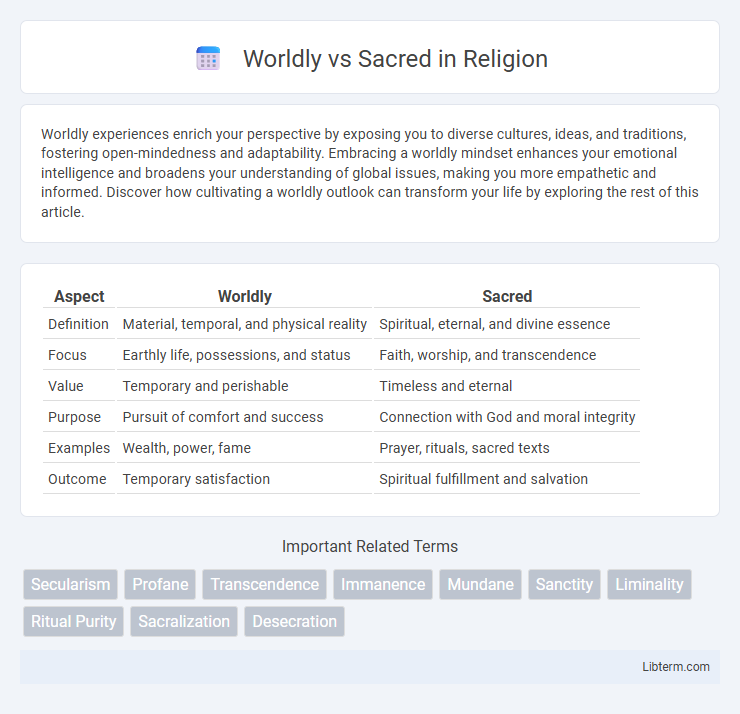Worldly experiences enrich your perspective by exposing you to diverse cultures, ideas, and traditions, fostering open-mindedness and adaptability. Embracing a worldly mindset enhances your emotional intelligence and broadens your understanding of global issues, making you more empathetic and informed. Discover how cultivating a worldly outlook can transform your life by exploring the rest of this article.
Table of Comparison
| Aspect | Worldly | Sacred |
|---|---|---|
| Definition | Material, temporal, and physical reality | Spiritual, eternal, and divine essence |
| Focus | Earthly life, possessions, and status | Faith, worship, and transcendence |
| Value | Temporary and perishable | Timeless and eternal |
| Purpose | Pursuit of comfort and success | Connection with God and moral integrity |
| Examples | Wealth, power, fame | Prayer, rituals, sacred texts |
| Outcome | Temporary satisfaction | Spiritual fulfillment and salvation |
Defining Worldly and Sacred: Key Concepts
Worldly refers to the material and secular aspects of life, including wealth, possessions, and everyday experiences tied to the physical realm. Sacred denotes elements associated with the divine, spiritual beliefs, and religious practices, often regarded as holy or set apart from ordinary life. Key concepts in defining these terms involve contrasting tangible, temporal realities with intangible, eternal values and rites.
Historical Perspectives on the Worldly and Sacred
Historical perspectives on the worldly and sacred often delineate a clear division between temporal, material concerns and spiritual, transcendent values. Ancient civilizations such as Mesopotamia and Egypt integrated sacred rituals into governance, blurring boundaries between divine authority and worldly power. In contrast, Enlightenment thinkers emphasized secularism, promoting the separation of sacred religion from worldly political and social structures.
Philosophical Foundations: Dualities Explored
Worldly and sacred represent fundamental dualities in philosophical thought, encapsulating the tensions between material existence and spiritual transcendence. Philosophers like Plato and Kant explored these realms through concepts such as the visible versus the intelligible and phenomena versus noumena, emphasizing the distinction between physical reality and metaphysical truths. This duality underscores diverse ethical frameworks, where worldly concerns prioritize empirical knowledge and practical living, while sacred dimensions invoke moral absolutism and spiritual meaning.
The Role of Religion in Shaping the Sacred
Religion fundamentally shapes the sacred by defining symbols, rituals, and spaces considered holy within diverse cultures. Sacred concepts often emerge from religious doctrines, influencing moral codes, social norms, and communal identity. These religious frameworks distinguish the sacred from the worldly, creating a structured sense of meaning beyond everyday experience.
Materialism and Spirituality: Points of Tension
Materialism emphasizes tangible wealth, possessions, and physical comfort, often leading to conflicts with spirituality, which values inner peace, enlightenment, and non-material fulfillment. The tension arises as material pursuits can distract from spiritual growth and foster attachment, while spirituality encourages detachment and transcending worldly desires. Balancing these opposing forces involves navigating the challenges between external accumulation and internal development.
Worldly Pursuits: Success, Wealth, and Desire
Worldly pursuits center on achieving success, accumulating wealth, and fulfilling desires, often driven by material gain and social status. These goals shape individual ambitions and societal values, influencing decisions in careers, investments, and lifestyle choices. The relentless pursuit of monetary riches and personal gratification frequently leads to increased competition and consumerism in modern economies.
Sacred Practices: Rituals, Beliefs, and Purpose
Sacred practices encompass rituals deeply rooted in religious or spiritual traditions, designed to connect individuals with the divine or transcendental realm. These rituals often include ceremonies, prayers, and symbolic acts meant to express faith, seek blessings, or attain spiritual enlightenment. Sacred beliefs underpin these practices, providing a framework that defines their purpose, such as fostering community cohesion, guiding moral conduct, or facilitating personal transformation.
Balancing the Worldly and Sacred in Modern Life
Balancing the worldly and sacred in modern life requires integrating spiritual practices into daily routines without neglecting material responsibilities. Mindfulness, meditation, and intentional reflection cultivate inner peace while engaging in work, relationships, and societal roles promotes holistic well-being. Embracing both dimensions enhances resilience, purpose, and a meaningful life amid contemporary challenges.
Cultural Interpretations of the Worldly vs Sacred
Cultural interpretations of the worldly versus the sacred vary widely, reflecting different societies' values and spiritual beliefs. In many indigenous cultures, the sacred is intertwined with nature, where rivers, mountains, and animals hold profound spiritual significance beyond their material existence. Contrastingly, Western secular perspectives often separate worldly activities from sacred rites, emphasizing a dichotomy that influences religious practices, ethical norms, and social behaviors across diverse communities.
The Future of Worldly and Sacred Values
The future of worldly and sacred values hinges on their evolving roles in shaping individual identity and societal norms amidst rapid technological advancement and global interconnectedness. Worldly values, centered on material success and empirical knowledge, increasingly intertwine with sacred values rooted in spirituality and ethical frameworks, creating complex cultural dynamics.Navigating these shifts requires balancing progress with preservation of core beliefs to foster resilience and meaningful human experiences.
Worldly Infographic

 libterm.com
libterm.com